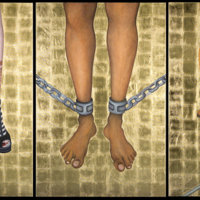
House Slave - Field Slave: A Portrait of Contemporary Slavery
'House Slave - Field Slave: A Portrait of Contemporary Slavery' was created in 2007 by Nicola Green in collaboration with Anti-Slavery International and first exhibited at Dulwich Picture Gallery. The artwork explored the concept of contemporary slavery and the stories of those still enslaved. The exhibition consisted of a large 'altarpiece' scale triptych set alongside artefacts of contemporary slavery from the International Slavery Museum and photos and text from Anti-Slavery International. It was later exhibited as part of Haringey's Black History Month at Bruce Castle Museum in 2010. The triptych is now in the permanent collection at the International Slavery Museum in Liverpool. Workshops were held at Dulwich Picture Gallery, The Prince’s Drawing Clubs, and International Slavery Museum in which students developed their skills in reading a work of art as a narrative, and responded by creating artworks that told their own personal story.
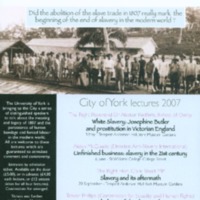
Slavery and Anti-Slavery in the Modern World
The City of York lectures in 2007 examined the question: Did the abolition of the slave trade in 1807 really mark the beginning of the end of slavery in the modern world? The University of York organised the public lecture series, which discussed the meaning and legacy of 1807 and the persistence of human bondage and forced labour in the modern world. Speakers included the Right Reverend Dr Alastair Redfern (Bishop of Derby), Aidan McQuade (Director, Anti-Slavery International), Clare Short MP and Trevor Phillips (Commission for Equality and Human Rights).
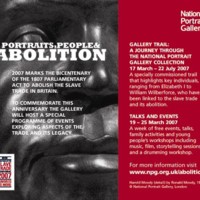
Portraits, People and Abolition
The National Portrait Gallery created a new gallery trail to mark the bicentenary, written by Dr Caroline Bressey. The trail highlighted portraits of key individuals, ranging from Elizabeth I to William Wilberforce, linked to the slave trade and its abolition. Portraits included those who invested in the trade, or who owned slaves and supported slavery, as well as images of enslaved people themselves and of people who were prominent in the movement to abolish the trade. The trail ended with a series of contemporary portraits of individuals involved in preventing slavery today. A week of talks, music, film and family activities included a discussion of the painting 'The Anti-Slavery Convention, 1840' by Benjamin Robert Haydon.
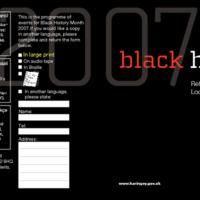
Haringey Council Black History Month
In consultation with the Black community in Haringey, the programme for Black History Month 2007 included many events to commemorate the bicentenary of the Abolition Act. Several took place at the Marcus Garvey Library in Tottenham, including poetry writing workshops, African drumming and dance workshops, and an exhibition and presentations led by Anti-Slavery International. There were several events to mark the bicentenary, including by Bedale House Supported Housing Scheme (featuring tenants' video diaries, a short film, poetry and guest speakers) and by Efiba Arts, supported by The Bridge New Deal for Communities. Haringey Council ran a poetry competition on the theme of slavery for young people aged 13-15. The winning entries were published in a pamphlet distributed to schools and libraries in the borough. Historian S. I. Martin led a guided tour of Haringey's places relating to the abolition of the slave trade. There was also a series of seminars by Robin Walker addressing 'Transatlantic Enslavement: What really happened?'.
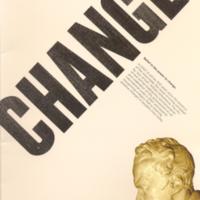
Wilberforce 2007
Wilberforce 2007 was a year-long programme of events from Hull City Council, commemorating the bicentenary and celebrating the city's diverse communities. The programme, named after 'son of Hull' William Wilberforce MP, was based around the themes of Pride, Freedom, Belief and Change. In partnership with Anti-Slavery International, Hull promoted the Fight for Freedom Petition against modern day slavery. The Wilberforce Lecture Trust held five specially commissioned lectures. The Wilberforce Weekender in July 2007 was a weekend of public events, including the Wilberforce Clipper Challenge Cup, Sankofa Sunsplash (celebrating African and Caribbean culture, food and music), Zapcat Racing, and the annual Jazz Festival. Throughout the year there were concerts and specially commissioned pieces from the Hull Choral Union, Hull Philharmonic, Hull Sinfonietta and the East Yorkshire Motor Services Brass Band. Other initiatives raised awareness of Fair Trade, and there was a variety of educational programmes and events. Funding was also made available for smaller community projects.
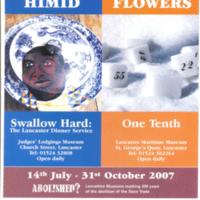
Abolished? Lancashire Museums marking 200 years of the abolition of the Slave Trade
Lancaster was the UK's fourth largest slaving port at the height of the transatlantic slave trade in the 18th century. Lancashire Museums worked with a range of partners to raise awareness of this largely hidden history - first from 2002 through STAMP (the Slave Trade Arts Memorial Project), and in 2007 through Abolished? This bicentenary project consisted of exhibitions, creative writing, radio broadcasts, and schools projects, one of which produced a Slavery Town Trail that explored some of the buildings made possible by the wealth the slave trade brought to Lancaster. At the heart of the project were commissioned installations and interventions by artists Lubaina Himid ('Swallow Hard: The Lancaster Dinner Service' at the Judge's Lodgings) and Sue Flowers ('One Tenth' at Lancaster Maritime Museum). Both were accompanied by outreach programmes and workshops with local schools. A touring exhibition was produced in partnership with Anti-Slavery International and Lancashire County Council Youth and Community, which looked at transatlantic slavery and modern day slavery. The exhibition toured throughout Lancashire.
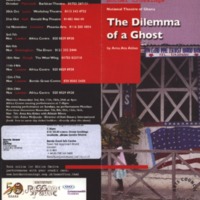
The Dilemma of a Ghost
Written by Ghanaian playwright Ama Ata Aidoo, The Dilemma of a Ghost deals with colliding cultures in 21st century Africa. An African-American woman accompanies her Ghanaian husband as he returns home, but the couple are haunted by ghosts of the inheritance of the slave trade. A collaboration between London theatre company Border Crossings and the National Theatre of Ghana, the production used music and dance to celebrate 50 years of Ghana’s independence and 200 years since the abolition of the transatlantic slave trade. The play was performed in Birmingham, Hull, Leeds, Leicester, London, Plymouth and Slough. The production was was accompanied by a new book from Border Crossings, working in collaboration with Anti-Slavery International. ‘Theatre and Slavery: Ghosts at the Crossroads’ explored the ways in which world theatre responds to key issues in modern society and politics, including the issue of contemporary slavery.
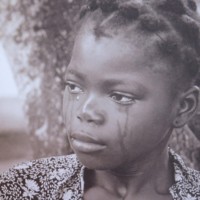
Remembering Slavery Exhibition
Remembering Slavery 2007 involved museums, galleries and other cultural organisations across the North East of England in a programme of exhibitions, events, performances, lectures and activities to explore the themes of slavery and abolition, and identify connections with the region.
The Remembering Slavery exhibition focused on objects, paintings, documents and other historical material relating to the transatlantic slave trade and its legacy. The exhibition and associated programme of activities opened at the Discovery Museum in Newcastle and then toured to South Shields Museum and Art Gallery; Sunderland Museum and Winter Gardens; and the Laing Art Gallery. Whilst at the Discovery Museum, the historical exhibition was accompanied by a photographic exhibition, ‘Human Traffic’, produced by Anti-Slavery International, documenting the trafficking of children in Benin and Gabon in West Africa. Whilst at the Laing Art Gallery, the exhibition was shown alongside ‘La Bouche du Roi’ by Romauld Hazoumé, a contemporary installation based on the ‘Brookes’ slave ship.
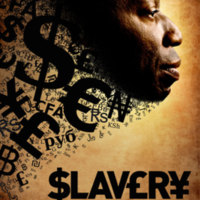
Slavery Not A Thing of the Past
Antislavery International commissioned poster. By foregrounding international currency symbols the image draws attention to the relationship between slavery and capitalism.
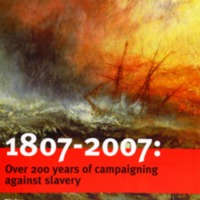
Anti-Slavery International, 2007
The world's oldest human rights organisation, Anti-Slavery International, led several initiatives in response to the bicentenary. The Fight for Freedom 1807-2007 Campaign, launched in 2005, called for measures to address the continuing legacies of the slave trade. The publication '1807-2007: Over 200 years of campaigning against slavery' looked back at the work of Anti-Slavery International and its predecessor organisations. The Spotlight on Slavery series of exhibitions and events included debates, lectures, film screenings and photography exhibitions. Anti-Slavery International also collaborated with a number of other organisations and projects in 2007, including Rendezvous of Victory and Set All Free, and contributed exhibition material to various exhibitions around the UK, including the Remembering Slavery exhibition at the Discovery Museum in Newcastle.